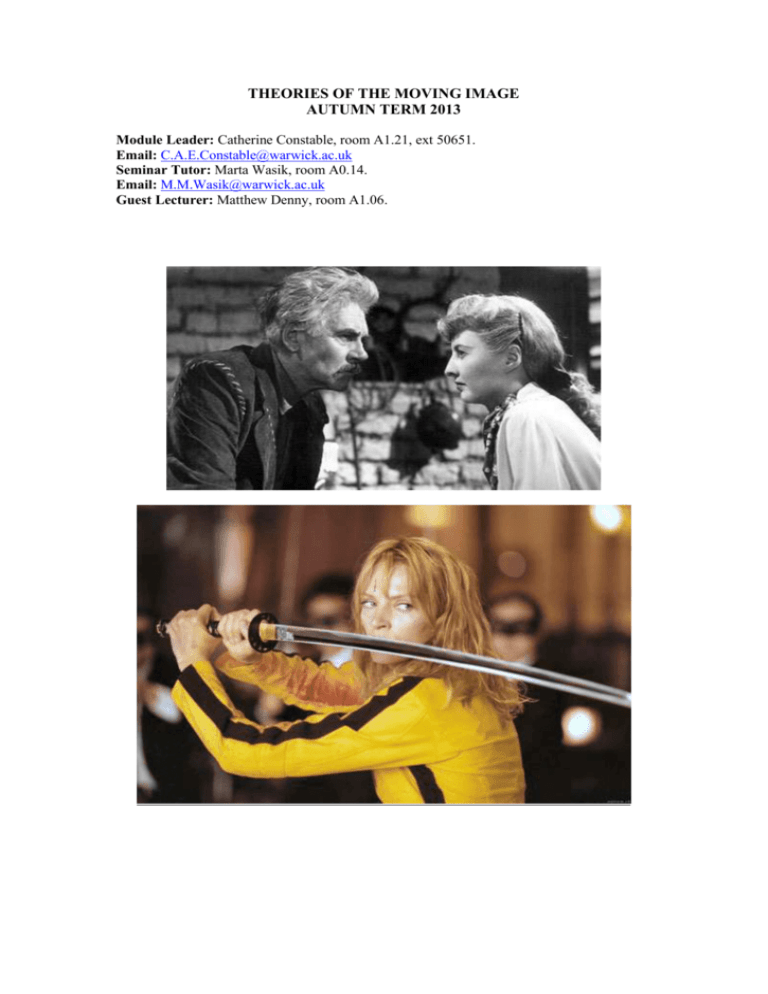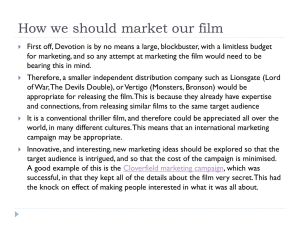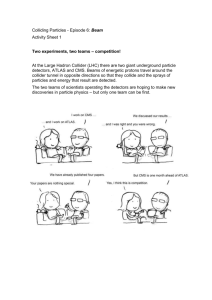
THEORIES OF THE MOVING IMAGE
AUTUMN TERM 2013
Module Leader: Catherine Constable, room A1.21, ext 50651.
Email: C.A.E.Constable@warwick.ac.uk
Seminar Tutor: Marta Wasik, room A0.14.
Email: M.M.Wasik@warwick.ac.uk
Guest Lecturer: Matthew Denny, room A1.06.
THEORIES OF THE MOVING IMAGE
RATIONALE
This unit will introduce you to a broad range of theories including structuralism,
psychoanalysis, deconstruction and postmodernism. The module will trace the ways in which
these theoretical models have been taken up by film theorists, focusing on the work of key
critics such as Laura Mulvey, Will Brooker and M Keith Booker. The module will also enable
you to analyse film texts from a variety of different theoretical standpoints.
SUMMARY OF AIMS
To provide an understanding of key movements within theory and their impact on
theorising within Film Studies.
To provide the opportunity to reflect on different theoretical frameworks and the
perspectives that they sustain and create.
To practice using conceptual and theoretical language with precision.
To apply the theoretical models, creating close textual analyses of specific film texts.
ANTICIPATED LEARNING OUTCOMES
You will be able to:
Locate the development of theoretical models in Film Studies within broader
interdisciplinary contexts.
Demonstrate a sound understanding of one or more areas of theoretical debate within
Film Studies.
Demonstrate an ability to deploy and to analyse argument in a rigorous way.
Demonstrate an ability to apply the theory to specific film texts and to add a conceptual
dimension to close textual analysis.
LEARNING AND TEACHING STRATEGY AND METHODS.
The course is structured into 4 two-week blocks. Each two-week block is dedicated to a
specific theoretical approach and we will address the primary theorists in the first week and
the secondary literature in the second. Each week will comprise a lecture, screening and
seminar. If the films exceed 2 hours, the lecture will be shorter to facilitate a break between
the screening and the seminar. All seminars will be structured around the week’s reading and
you are expected to be thoroughly prepared for the seminar discussions.
ASSESSMENT
Formative Assessment.
A short essay of 1,000 words comprising a detailed summary of a particular theoretical
position and a theoretical reading of ONE specific film text. The aim of this essay is to
provide you with a chance to practice writing clear summaries of theoretical positions and
applying theory to film. The essay may be used as the basis for the longer version OR as the
basis of exam revision. The deadline date is Tuesday 5/11/13 (week 6 of Autumn term).
Summative Assessment.
A long essay of 2,000 words – 25% of the total mark. Essay questions are on pp. 6-7.
Each includes an analysis of one particular theoretical approach and a demonstration
of its usefulness for reading films by focusing on one particular film text. The
deadline date is Friday 13/12/13.
Exam – 25% of the total mark. A two-hour exam comprising two sections (one from
each term’s work for the module). You are required to answer one question from each
section. Date of the exam to be announced.
The other 50% of the total mark for the module is generated from the second term’s work.
WEEKLY SCHEDULE
The required reading for each week (except week 2) can be found at:
http://www2.warwick.ac.uk/services/library/main/electronicresources/extracts/fi/fi108
You are expected to bring a paper copy of the required reading to the seminar.
Block 1: Structuralism
Week 2: Structuralist Linguistics
Lecture: An introduction to the module as a whole. An introduction to the structuralist model
of language.
Screening: Alien (Ridley Scott, 1979).
Seminar: An assessment of the structuralist approach to reading images through a detailed
examination of Barthes’ essay and selected film extracts from Alien.
Seminar Reading: R. Barthes, “The World of Wrestling”, Mythologies, A. Lavers (trans.),
London, Grafton Books, 1973, pp. 15-26.
Further Reading: J. Culler, “The Linguistic Basis of Structuralism”, Introduction to
Structuralism, D. Robey (ed.), Oxford, Oxford University Press, 1973.
R. Stam, “The Advent of Structuralism”, Film Theory: An Introduction, Oxford, Blackwell
Publishers, 2000, pp. 102-118.
J. Culler, Structuralist Poetics, London, R.K.P., 1975.
P. Cook, “Lévi-Strauss” and “Propp”, The Cinema Book, B.F.I., London, 1985, pp. 232-237.
Week 3: Propp
Lecture: Propp’s definition of the basic structures of narrative as a set of “functions”. His
analysis of narrative in terms of ‘action’ and the implications that this has for reading
characters.
Screening: Pretty Woman (Garry Marshall, 1990).
Seminar: A detailed engagement with Propp’s methodology for reading images and an
application of Proppian functions to Pretty Woman.
Seminar Reading: selected extracts from V. Propp, The Morphology of the Folk Tale,
University of Texas Press, Texas, 1968, pp. 14-36. Photocopies to be provided.
Further Reading: P. Erens, “Sunset Boulevard: A Morphological Analysis”, Film Reader,
volume 2, 1977, pp. 90-95. Photocopy to be provided.
J. Fell, “Vladimir Propp in Hollywood”, Film Quarterly, vol 30, no 3, Spring 1977.
Block 2: Psychoanalysis
Week 4: Oedipus
Lecture: Freud’s take up of the Oedipus myth and associated plays and his reworking of them
as steps in subject formation. Issues arising from Freud’s modelling of femininity as a bad
copy of masculinity.
Screening: The Furies (Anthony Mann, 1950).
Seminar: A discussion of the ways in which Freud defines subject formation and an analysis
of the oppositional construction of gender in his model. The application of Freud’s model to
two films: Liebelei (Max Ophuls, 1932) and The Furies.
Seminar Reading: S. Freud, “The Dissolution of the Oedipus Complex”, On Sexuality, J.
Strachey (tr.), London: Penguin Books, 1991, pp. 313-322. Originally published 1924.
Further Reading: S. Freud, “Female Sexuality”, On Sexuality, J. Strachey (tr.), London:
Penguin Books, 1991, pp. 367-392. Originally published 1931.
S. Freud, “The Ego and the Id”, On Meta-psychology and the Theory of Psychoanalysis, J.
Strachey (tr.), London: Penguin Books, 1991, pp. 339-407.
S. Freud, “Some Psychical Consequences of the Anatomical Distinction Between the Sexes”,
J. Strachey (tr.), London: Penguin Books, 1991, pp. 323-344. Originally published 1925.
S. Freud, “Femininity”, New Introductory Lectures on Psychoanalysis, J. Strachey (tr.),
London: Penguin Books, 1991, pp. 145-169.
Week 5: Mulvey
Lecture: Mulvey’s analysis of Oedipal narrative. Aspects of Freud’s analysis of dreaming that
are useful in thinking about Blue Velvet.
Screening: Blue Velvet (David Lynch, 1986).
Seminar: A discussion of Mulvey's reading of Blue Velvet and the ways in which it goes
beyond the Freudian paradigms.
Seminar Reading: L. Mulvey, “The Oedipus Myth: Beyond the Riddles of the Sphinx”, Visual
and Other Pleasures, Macmillan, London, 1989, pp. 177-201.
Further Reading: B. Creed, “Film and Psychoanalysis”, The Oxford Guide to Film Studies,
Oxford, Oxford University Press, 1998, pp. 77-90.
R. Bellour, “Hitchcock the Enunciator”, Camera Obscura, volume 2, Spring 1979.
L. Mulvey, “Visual Pleasure and Narrative Cinema”, Visual and Other Pleasures, Macmillan,
London, 1989, pp. 14-26.
L. Mulvey, Fetishism and Curiosity, Bloomington, Indiana, Indiana University Press, 1996.
K. Silverman, The Subject of Semiotics, Oxford, Oxford University Press, 1983. Chapter one
is a good guide to major theorists.
Week 6: Reading Week. Formative essay due in on Tuesday 5/11/13.
Block 3: Deconstruction
Week 7: Derrida
Lecture: An introduction to deconstruction and the key concept of différance. An analysis of
the ways in which deconstruction eliminates particular constructions of truth through an
examination of Derrida’s reading of the figures of woman in Nietzsche’s work.
Screening: The Devil is a Woman (Josef von Sternberg, 1935).
Seminar: An assessment of the extent to which deconstruction offers a method of reading
texts that constitutes a radical break away from models of depth and truth favoured by
psychoanalysis. A discussion of the extent to which Concha epitomises different figures of
woman and truth across The Devil is a Woman.
Reading: Section entitled “I have forgotten my umbrella” from J. Derrida, Spurs: Nietzsche’s
Styles, B. Harlow (tr.), Chicago, University of Chicago Press, 1979, pp. 123-133.
Further Reading: M-A. Doane, Femmes Fatales, London, Routledge, 1991, chapter 3, pp. 4475.
C. Constable, Thinking in Images: Film Theory, Feminist Philosophy and Marlene Dietrich,
London, B.F.I., 2004.
T. Moi, Sexual/Textual Politics, London, Methuen and Co, 1985. A good summary of
Derrida’s position is provided at the beginning of the chapter on Cixous (see especially
pp.104-107).
J. Derrida, Positions, A. Bass (tr.) London, Athlone Press, 1987. A selection of interviews
with Derrida in which he offers clearer definitions of some of his key arguments and
concepts.
Week 8: Palimpsest and Pharmakon
Lecture: Defining the Derridean palimpsest. A consideration of the many variant versions of
Batman, which Nolan’s Batman Begins mobilises.
Screening: Batman Begins (Christopher Nolan, 2005). (Long screening 140 mins)
Seminar: A discussion of the ways in which Batman Begins reworks its key intertexts. An
analysis of the meaning of ‘pharmakon’ and the ways in which Brooker deploys the term in
order to set up a deconstructive reading of Batman.
Seminar Reading: Chapter 5: “The Never-Ending War: Deconstruction and The Dark Knight”
from W. Brooker, Hunting the Dark Knight: Twenty-first Century Batman, I. B. Tauris, 2012,
pp. 178-211.
Further Reading: R. Stam, “The Poststructuralist Mutation” and “Textual Analysis”, Film
Theory: An Introduction, Oxford, Blackwell Publishers, 2000, pp. 179-192. A good, reliable
introduction.
P. Brunette, “Post-structuralism and Deconstruction”, The Oxford Guide to Film Studies,
Oxford, Oxford University Press, 1998, pp. 91-95.
Block 4: Postmodernism
Week 9: Jameson and postmodern pastiche
Lecture: An introduction to different forms of postmodernism, focusing on Jameson’s
analysis of postmodern style.
Screening: Kill Bill Vol. 1 (Quentin Tarantino, 2003).
Seminar: A discussion of Jameson’s controversial definition of postmodern style, specifically
his conception of pastiche and its relevance for Tarantino. An assessment of the ways in
which Kill Bill Vol 1. both exemplifies and subverts this aesthetic.
Seminar Reading: F. Jameson, “Postmodernism and Consumer Society” in Hal Foster (ed.),
Postmodern Culture, London, Pluto, 1985, pp. 111-125.
Further Reading: “MTV and the avant-garde: the emergence of a postmodernist antiaesthetic?” in E. A. Kaplan, Rocking Around the Clock: Music Television, Postmodernism
and Consumer Culture, London, Methuen, 1987, pp. 33-48. While this piece focuses on the
music video, Kaplan does delineate a number of key features of postmodern style.
C. Constable, “Postmodernism and Film”, The Cambridge Companion to Postmodernism, S.
Connor (ed.) Cambridge, C. U. P., 2004, pp. 43-61.
J. Hill, “Film and Postmodernism”, The Oxford Guide to Film Studies, Oxford, Oxford
University Press, 1998, pp. 96-105.
Week 10: Postmodern Hollywood
Lecture: Post-classical or postmodern Hollywood – a review of endeavours to define a
particular era of postmodern style within Hollywood film making.
Screening: Kill Bill Vol 2. (Quentin Tarantino, 2004). (Long screening 137 mins)
Seminar: A discussion of the ways in which Kill Bill Vol. 2 exemplifies postmodern style and
the ways in which the second film references and reworks the first.
Reading: M. K. Booker, Postmodern Hollywood, Praeger, 2007, chapter 3, especially pp. 8997.
Further Reading: E. Gallafent, “Chapter 7: Kill Bill excursion into style”, Quentin Tarantino,
Pearson Longman: New York, 2006, pp. 99-121.
P. Brooker and W. Brooker, “Pulpmodernism: Tarantino’s affirmative action” in P. Brooker
and W. Brooker (eds) Postmodern After-Images: A Reader in Film, Television and Video,
London: Arnold, 1997, pp. 89-100.
Week 11: Summative essay due in on Friday 13/12/13.
ASSESSMENT
FORMATIVE ASSESSMENT
A 1,000-word essay on the work of ONE of the key theoretical approaches studied on the
module so far. It is due in on Tuesday 5/11/13 (week 6 of Autumn term).
The essay should consist of two equal sections:
1. An outline of ONE of the theoretical approaches from the module. You should aim to
engage with some of the primary material (e.g. Freud for psychoanalysis). Limit the
use of quotes and summarise the key features of the chosen theoretical approach in
your own words. (500 words)
2. Apply your chosen theoretical approach to ONE particular film from the module. The
detailed textual analysis can be presented as a series of bullet points but these must be
written up in full sentences. You can use any film from the module in relation to your
chosen theorist. (500 words)
N.B. This is your opportunity to practice writing clear summaries of theoretical positions and
applying theory to film. The essay may be used as the basis for the summative essay OR
exam revision.
SUMMATIVE ASSESSMENT
A 2,000 word essay. Your essay should provide a clear analysis of ONE particular
theoretical approach and a demonstration of its usefulness for reading texts through the
application of techniques of detailed textual analysis to TWO or THREE specific
scenes/sequences from your chosen film. It is due in on Friday 13/12/13 (week 11 of the
Autumn term).
1) Utilising a key example from Barthes’ Mythologies, explain what you understand by a
structuralist approach to meaning construction and provide a structuralist reading of Alien.
2) Outline Propp’s morphological approach for analysing folk tales. Provide a detailed
Proppian analysis of ALL the following scenes from Pretty Woman:
1. the scene in which Edward and Vivian kiss for the first time (scene 15 on the DVD
or 1 hour 30 mins) up to Edward’s exit from the penthouse (1 hour 36 mins)
2. Phillip Stuckey’s visit to Vivian (scene 17 or 1 hour 43 minutes) to Vivian’s return
home in the limousine (1 hour 50 mins)
3. Edward’s arrival in the limousine at Vivian’s apartment block (scene 19 and fast
forward for 3 mins or 1 hour 55 mins) to the end of the film.
3) Utilising Freud’s analysis of the ‘circuitous’ psychic journey of the little girl, provide a
psychoanalytic reading of the relationships between the main protagonists in The Furies.
4) Consider the ways in which Mulvey’s figure of the primal father reworks Freud’s Oedipus
and castration complexes. Utilising BOTH Mulvey and Freud, provide a psychoanalytic
reading of the relationships between the main protagonists in Blue Velvet.
5) Summarize Derrida’s account of woman as three different configurations of knowledge
and meaning: ‘nontruth’, truth and ‘the untruth of truth’. Use any/all of these concepts to
create a deconstructive reading of Concha in The Devil is a Woman.
6) Outline Derrida’s approach to meaning construction, drawing on his analysis of the
‘pharmakon’. Following Brooker, consider the ways in which this concept can be utilised to
create a detailed post-structuralist analysis of Batman Begins.
7) Explain how, for Jameson, postmodern pastiche constitutes the death of parody. Using key
scenes from Kill Bill Vol. 1 and/or Kill Bill Vol. 2, consider whether the film/films are best
conceptualised as EITHER pastiche OR parody.
8) How does Jameson define postmodern style? Consider the ways in which his definition is
BOTH exemplified and challenged through a detailed analysis of Kill Bill Vol. 1 and/or Kill
Bill Vol. 2.
NB You cannot write on the same topic for the essay and the exam.
So, for example, if you answer either question 1 or question 2, you cannot write on
structuralism in the exam.





